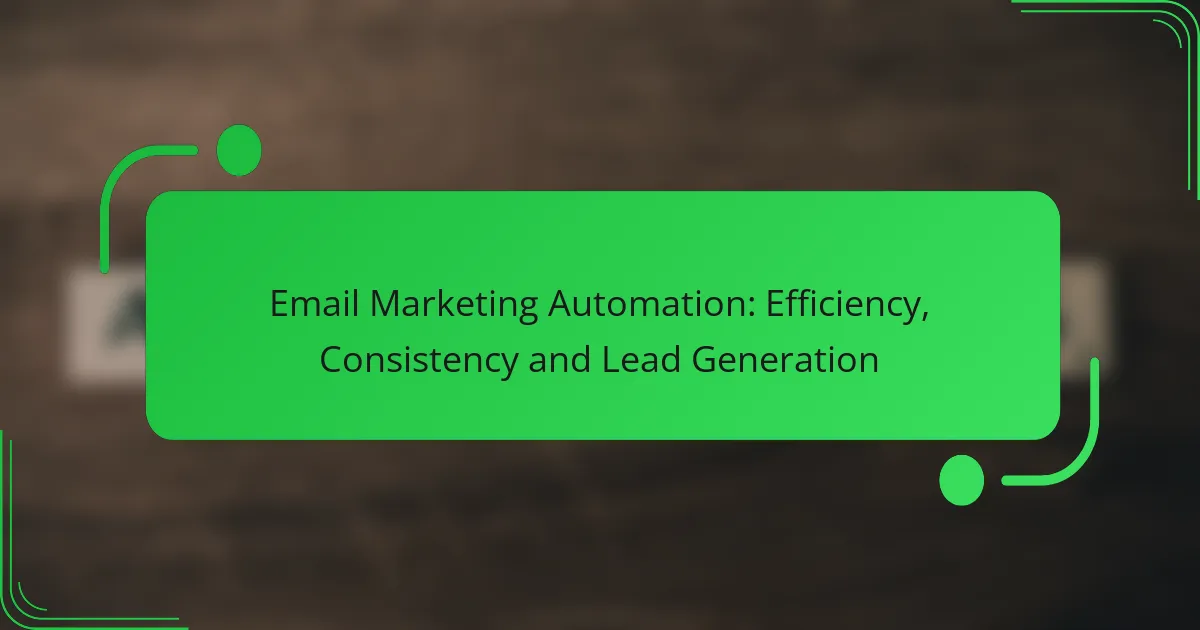Email metrics are essential for improving lead generation by offering valuable insights into how recipients interact with campaigns. By closely monitoring metrics such as open rates, click-through rates, and conversion rates, businesses can effectively refine their strategies to boost engagement and drive conversions. Optimizing these metrics involves targeted approaches, including list refinement and personalized content, to ensure maximum impact on audience engagement.

How can email metrics improve lead generation in the US?
Email metrics play a crucial role in enhancing lead generation efforts in the US by providing insights into recipient engagement and campaign effectiveness. By analyzing metrics such as open rates, click-through rates, and conversion tracking, businesses can refine their strategies to attract and convert more leads.
Increased open rates
Increased open rates indicate that your email subject lines and sender reputation resonate with your audience. A higher open rate can be achieved by personalizing subject lines, optimizing send times, and segmenting your email list based on user behavior.
For instance, A/B testing different subject lines can help identify what captures attention best. Aim for open rates in the range of 15-25% for most industries, but strive for higher percentages in niche markets.
Higher click-through rates
Higher click-through rates (CTR) reflect effective content and calls to action within your emails. A strong CTR suggests that your audience finds your emails engaging and is motivated to take the desired action.
To improve CTR, ensure that your email content is relevant and includes clear, compelling calls to action. Typical CTRs range from 2-5%, but optimizing your email design and content can push these numbers higher.
Better conversion tracking
Better conversion tracking allows you to measure the effectiveness of your email campaigns in generating leads. By setting up conversion goals in your analytics platform, you can see which emails lead to sign-ups, purchases, or other desired actions.
Utilize UTM parameters to track the performance of individual email campaigns. This data can guide future strategies, helping you focus on what works best for your audience and improve overall lead generation efforts.

What key email metrics should be analyzed?
Analyzing key email metrics is crucial for understanding the effectiveness of your email campaigns. Focus on metrics like open rate, click-through rate, conversion rate, and bounce rate to gauge engagement and optimize performance.
Open rate
The open rate measures the percentage of recipients who open your email compared to the total number of emails delivered. A typical open rate ranges from 15% to 25%, depending on the industry and audience.
To improve your open rates, consider crafting compelling subject lines and personalizing your emails. Avoid spammy language that could trigger filters and ensure your emails are mobile-friendly.
Click-through rate
The click-through rate (CTR) indicates the percentage of recipients who clicked on one or more links within your email. A good CTR usually falls between 2% and 5%, but this can vary based on your sector.
Enhance your CTR by including clear calls to action and engaging content. A/B testing different layouts and link placements can help identify what resonates best with your audience.
Conversion rate
The conversion rate measures the percentage of recipients who completed a desired action after clicking through your email, such as making a purchase or signing up for a newsletter. Typical conversion rates can range from 1% to 5%.
To boost conversion rates, ensure your landing pages are relevant to your email content and provide a seamless user experience. Highlight benefits and include testimonials to build trust and encourage action.
Bounce rate
Bounce rate refers to the percentage of emails that could not be delivered to recipients’ inboxes. A bounce rate below 2% is generally considered acceptable, while higher rates may indicate issues with your email list quality.
To reduce bounce rates, regularly clean your email list by removing inactive or invalid addresses. Use double opt-in methods to ensure subscribers genuinely want to receive your emails.

How to optimize email metrics for better performance?
To optimize email metrics for better performance, focus on enhancing engagement through targeted strategies. This involves refining your email lists, personalizing content, and testing various elements to identify what resonates best with your audience.
Segmenting email lists
Segmenting email lists involves dividing your subscribers into smaller groups based on specific criteria such as demographics, purchase history, or engagement levels. This targeted approach allows you to tailor your messaging to meet the unique needs of each segment, leading to higher open and click-through rates.
Consider using criteria like geographic location, interests, or past interactions to create segments. For example, you might have separate lists for new subscribers, frequent buyers, and those who haven’t engaged recently. This ensures your emails are relevant and timely.
Personalizing email content
Personalizing email content means customizing messages to individual recipients based on their preferences and behaviors. This can include using their name in the subject line, recommending products based on past purchases, or sending tailored offers.
Effective personalization can significantly boost engagement rates. For instance, emails that include personalized subject lines can increase open rates by a notable percentage. Always ensure that your personalization efforts comply with data protection regulations, such as GDPR in Europe.
A/B testing subject lines
A/B testing subject lines involves sending two variations of an email to different segments of your audience to determine which subject line performs better. This method helps identify what language, tone, or style resonates most with your subscribers.
When conducting A/B tests, keep the variations simple—change only one element at a time, such as the wording or length of the subject line. Aim for a sample size that reflects your overall audience to ensure reliable results. Regularly testing and refining your subject lines can lead to improved open rates and overall email performance.

What tools are available for email metrics analysis?
Several tools are available for email metrics analysis, each offering unique features to track and optimize email performance. These tools help marketers understand engagement levels, conversion rates, and overall effectiveness of their email campaigns.
Mailchimp
Mailchimp is a popular email marketing platform that provides comprehensive analytics for email campaigns. Users can access metrics such as open rates, click-through rates, and subscriber growth, allowing for effective performance tracking.
One key feature is the A/B testing capability, which enables marketers to compare different email versions to see which performs better. This can lead to improved engagement and higher conversion rates over time.
HubSpot
HubSpot offers a robust email marketing tool integrated with its CRM, making it easy to analyze email performance in the context of customer interactions. Users can track metrics like engagement rates and lead conversions directly linked to email campaigns.
Additionally, HubSpot provides detailed reports that help identify trends and optimize future campaigns. The platform’s automation features allow for personalized follow-ups based on user behavior, enhancing lead generation efforts.
Google Analytics
Google Analytics can be utilized to track email campaign performance by monitoring traffic and conversions from email links. By setting up UTM parameters, marketers can gain insights into how email campaigns drive website activity and user behavior.
Using Google Analytics, you can analyze metrics such as bounce rates and session durations for visitors coming from emails. This data helps refine email strategies and improve overall marketing effectiveness.

What are the prerequisites for effective email metric analysis?
Effective email metric analysis requires clear objectives, well-maintained email lists, and a robust tracking setup. These elements ensure that the data collected is relevant and actionable, leading to improved email performance and better lead generation outcomes.
Defined goals
Establishing defined goals is crucial for effective email metric analysis. Goals should be specific, measurable, achievable, relevant, and time-bound (SMART). For example, aiming to increase open rates by 15% over the next quarter provides a clear target to work towards.
Consider what you want to achieve with your email campaigns, whether it’s boosting engagement, generating leads, or driving sales. Aligning your metrics with these goals will help you focus on the most relevant data.
Clean email lists
Maintaining clean email lists is essential for accurate metric analysis. Regularly remove inactive subscribers and ensure that your list complies with regulations such as GDPR or CAN-SPAM. A clean list enhances deliverability and improves engagement rates.
Implement practices such as double opt-in to confirm subscriptions and periodic list cleaning to remove duplicates or invalid addresses. This helps maintain a high sender reputation and maximizes the effectiveness of your campaigns.
Tracking setup
A proper tracking setup is vital for collecting accurate email metrics. Utilize tools like UTM parameters to track campaign performance across different channels. Ensure that your email service provider (ESP) supports comprehensive analytics to monitor key metrics such as open rates, click-through rates, and conversions.
Regularly review and adjust your tracking setup to align with your evolving goals. This may include setting up conversion tracking for specific actions on your website, allowing you to measure the direct impact of your email campaigns on lead generation and sales.

How to interpret email metrics results?
Interpreting email metrics results involves analyzing key performance indicators (KPIs) to gauge the effectiveness of your email campaigns. Focus on metrics like open rates, click-through rates, and conversion rates to understand audience engagement and identify areas for improvement.
Identifying trends
Identifying trends in email metrics helps you understand how your campaigns are performing over time. Look for patterns in open rates and click-through rates across different segments or time periods to determine what resonates with your audience.
For instance, if you notice a consistent increase in open rates during certain months, consider adjusting your future campaigns to align with those periods. Additionally, tracking metrics over several campaigns can reveal whether changes in subject lines or content types lead to better engagement.
To effectively identify trends, create a simple dashboard that visualizes your key metrics over time. This can be done using spreadsheet software or specialized email marketing tools, allowing you to quickly spot upward or downward trends and make data-driven decisions.


